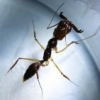Need some advice on how to get a queen to relocate when she really doesnt want to. Twice this has happened and its putting a lot of stress on her as well as being ridiculously annoying. She is still in her claustral tube after two months with nothing to show for it but brood that ends up dying or disappearing. both times her tube ran out of water.
The first time we tried to relocate her from her small plastic tube into a bigger glass tube with fresh cotton and plentiful water. We did the usual thing where you cover the new tube and leave the old one exposed. After several hours of the queen mucking around we eventually gave up and refilled her plastic test tube while she and her brood camped out in a spare length of plastic tubing. She kept going to explore the new space but as soon as her feet touched the glass she would immediately run back to her eggs, so we figured she just didn't like the feel of the glass. Unfortunately she ended up losing half her egg pile in the process.
The second time she got as far as having three very large pupae (but no eggs or larva) before she ran out of water again. all three pupae have gradually disappeared and she now has only a tiny clump of eggs. Knowing that she didn't like glass test tubes, we prepared a nice warm humid claustral chamber for her made from concrete sitting on a very gentle heating pad. At least this time she would go inside and explore, but instead of moving in she dumped her rubbish in there and tried to block off the entry hole with cotton pulled from the water plug. I tried to coax her in there with some sugar protein that I know she likes, but she still wouldn't move in.
My problem is that she can't stay where she is, but I can't get her to move into somewhere better. I'm having to feed her sugar water laced with protein or she gets lethargic and very wobbly on her feet, her water keeps running out, and she is getting more and more stressed. Every time I stick a needle into her tiny little space to give her food she freaks out, and it inevitably ends up full of cotton fibres. usually once she realises that its a food offering she calms down, but in the meantime her stress levels are spiked.
anyone got any suggestions on what I can do to get her relocated without killing her?


















